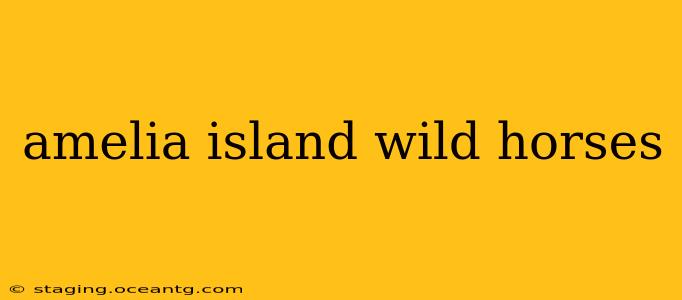Amelia Island, a picturesque gem off the coast of Florida, is renowned for its pristine beaches, lush forests, and charming historic towns. But beyond the typical tourist attractions lies a captivating story etched into the island's very fabric: its wild horses. These majestic creatures, roaming freely across the island's expansive landscapes, are not just a spectacle; they're a living testament to the island's rich history and a significant part of its unique identity. This article delves into the captivating world of Amelia Island's wild horses, exploring their origins, their current status, and the ongoing efforts to protect these iconic animals.
Where Did the Amelia Island Wild Horses Come From?
The origins of Amelia Island's wild horses are shrouded in a bit of mystery, adding to their allure. Several theories exist, but the most widely accepted suggests that the horses are descendants of Spanish Mustangs brought to the island centuries ago. These hardy animals, known for their resilience and adaptability, likely escaped or were intentionally released, establishing a thriving feral population that has endured to this day. Their genetics are still being studied, further deepening our understanding of their lineage and the unique adaptations they’ve developed.
How Many Wild Horses Are on Amelia Island?
Determining the precise number of wild horses on Amelia Island is an ongoing challenge. Their elusive nature and the vastness of their roaming territory make accurate counts difficult. However, through careful monitoring and population studies conducted by organizations dedicated to their conservation, a general estimate can be made. While the numbers fluctuate, the population is carefully managed to ensure the horses' well-being and the preservation of the island's ecosystem.
What Do the Amelia Island Wild Horses Eat?
The diet of Amelia Island's wild horses is surprisingly diverse, reflecting the varied vegetation of their habitat. They primarily graze on grasses, shrubs, and other natural vegetation found throughout the island's coastal plains, marshes, and maritime forests. Their diet can vary seasonally depending on the availability of different plant species, showcasing their remarkable adaptability.
Are the Amelia Island Wild Horses Safe?
While the wild horses of Amelia Island are a captivating sight, it's crucial to remember they are wild animals and should be observed from a respectful distance. Approaching or interacting with them can be dangerous, both for you and the horses. Maintaining a safe viewing distance ensures their safety and prevents potential disruptions to their natural behaviors and herd dynamics. Always follow the guidelines provided by local authorities and responsible wildlife organizations.
Where Can I See the Amelia Island Wild Horses?
Spotting Amelia Island's wild horses requires a bit of patience and exploration. They are most commonly sighted in the northern and eastern parts of the island, particularly in areas with less human development. While there aren't designated viewing areas, driving along the island's scenic backroads and exploring the beaches at dawn or dusk can increase your chances of encountering these magnificent animals. Remember to be mindful and respectful of their environment and always prioritize their safety.
How Are the Amelia Island Wild Horses Protected?
The preservation of Amelia Island's wild horses is a collaborative effort involving local organizations, government agencies, and concerned citizens. Various programs and initiatives focus on monitoring their health, managing their population, and ensuring the protection of their habitat. These efforts aim to maintain a healthy and sustainable population while minimizing human impact on their environment. Furthermore, educational outreach programs strive to raise awareness about the importance of responsible wildlife viewing and the vital role these animals play in the island's ecosystem.
Conclusion
The wild horses of Amelia Island are more than just an attraction; they are an integral part of the island's unique character and a symbol of its enduring natural beauty. Their continued survival depends on our collective commitment to their conservation and the preservation of their habitat. By respecting their wild nature and supporting the efforts of those working to protect them, we can ensure that these magnificent creatures remain a cherished icon of Amelia Island for generations to come.
